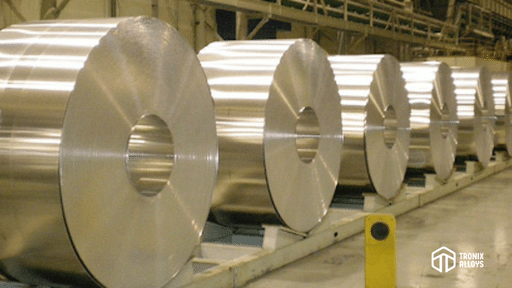
There are two grades of austenitic stainless steel plate, 321 and 321H, which are stabilized by titanium additions. These grades are commonly used for applications in temperatures up to 1,650 degrees Fahrenheit. There are many characteristics of these plate grades, including their strength, resistance to scaling, phase stability, as well as their ability to resist subsequent aqueous corrosion. 304L plate is available in a much more comprehensive range of form than 321 or 321H, so it is generally used in preference to those ss 321 materials if the requirement is just resistance to intergranular corrosion after welding. Even so, 304L is less heat resistant than 321 and 321H plates, so it may not be the best option if you need to endure a heat environment that is exceeding 932 degrees Fahrenheit.
We as a manufacturer of plate mill plate stock these grades of stainless steel plates. Penn Stainless Products is a manufacturer of plate mill plate. There are several sizes and thicknesses available for these plate grades from Penn Stainless; contact Penn Stainless for more information. These sizes and thicknesses can be purchased in a variety of lengths and widths.
A stainless steel plate and sheet made of stainless steel 321/321H, which is stabilized in Titanium, has excellent mechanical properties, as well. After exposing the stainless steel sheets and plates to the chromium carbide range of temperatures, they will have outstanding corrosion resistance, and they will also have excellent intergranular corrosion resistance. The stainless steel plate 321/321H also has a better creep and stress rupture property than other alloys. The steel plate also has high strength and excellent low temperature toughness. Furthermore, these 321h plates are also suitable to be used in diluted organic acids at moderate temperatures too. In addition, they also come with certain other advantages such as high tensile strength, durability and a precise design.
STAINLESS STEEL PLATE 321 AND 321H CHEMICAL COMPOSITION
This grade differs from the 321H grade in that it contains up to 0.10% carbon, while the 321H grade contains between 0.04% and 0.10% carbon. This grade contains at most 0.08% carbon, while the 321H grade contains at most 0.04% carbon. Their manganese content is 2.0%, silicon content is 0.75%, and phosphorous content is 0.045%. Additionally, the steel has a sulfur content of at most 0.03%, chromium content of between 17.0% to 19.0%, and nitrogen content of no more than 0.10%. The addition of titanium is what gives 321 and 321H stainless steel plates their unique properties. The amount of titanium that can be added to the product can also reach 0.70%.
MECHANICAL PROPERTIES OF 321 AND 321H STAINLESS STEEL PLATE
On the Brinell hardness scale, both 321 and 321H stainless steel have a hardness of 217 and on the Rockwell B scale both 321 and 321H stainless steel have a hardness of 95, which is the same as the tensile strength. On the Brinell hardness scale, both 321 and 321H stainless steel have a hardness of 217. They both have an elongation of 40%, too.
PHYSICAL PROPERTIES
The density of this stainless steel is 0.2891 kg/in3, while the modulus of elasticity is 193 GPA. There is a 9.22in x 10-6 coefficient of thermal expansion between 32°F and 212°F, and a 9.56in x 10-6 coefficient between 32°F and 599°F.
321 stainless steel bar plate has a coefficient of thermal expansion between 32°F and 1,000°F of 1.03in x10^-5. There is a calculated specific heat of 0.194 BTU/IBM for stainless steel plate 321 in the laboratory.
APPLICATIONS AND USAGE
This stainless steel plate can be used in many different applications in environments with high temperatures. These stainless steel plates are commonly used in heat exchangers, bellows, expansion joints, heating elements, spiral welded tubes, and furnace parts, to name just a few. Stainless steel plates of the same grade can also be used to manufacture woven or welded metal screens which are used in mineral processing environments at high temperatures. Specifically, it is used in aircraft exhausts and piston engine manifolds in the aerospace industry. These grades are also useful in the chemical and food processing industries, specifically in equipment and storage, which are used in both these industries. As well as the petroleum refining industry, it is also used in chemical industries as well as waste treatment processes for wastes to be treated. It is more common to use these grades in Europe rather than North America.
PROCESSING AND FABRICATION OPTIONS
- Cold Forming
It is relatively easy to form and ductile alloys made from this material.
- Hot Forming
It is also important to keep in mind that Alloy 303’s high sulfur content may adversely affect its hot workability. If hot forming is required, again, Alloy 304 should be considered as an alternative.
- Machining
There are some differences between ss321 plate and 410 stainless steel plate that may affect its machinability. The following table provides relevant data regarding 321 stainless steel.
- Forming
Alloys made with this alloy tend to be ductile and form easily.
- Hot Forming
It is also important to keep in mind that Alloy 303’s high sulfur content may adversely affect its hot workability. If hot forming is required, again, Alloy 304 should be considered as an alternative.
- Machining
There are some differences between 321 stainless steel plate and 410 stainless steel plate that may affect its machinability. The following table provides relevant data regarding 321 stainless steel tubing.

